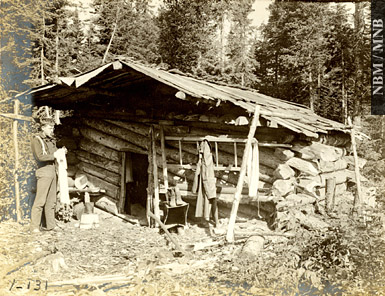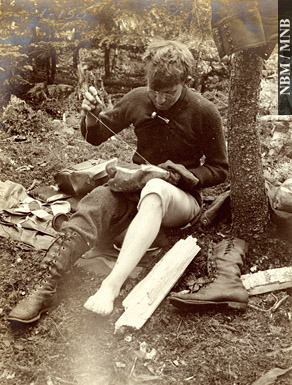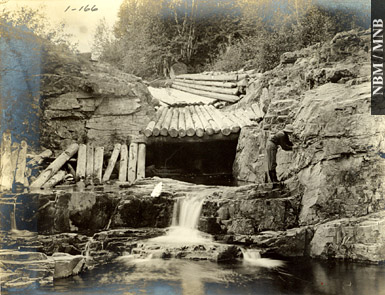|
William Francis Ganong's field trips around the province of New Brunswick
 By the late nineteenth and early twentieth centuries most of the interior topography of New Brunswick had not yet been completely surveyed. While the aboriginal community had an intimate knowledge of the intricate waterways and expansive forests, little mapping or charting had been undertaken. Driven by a great affection for his home province, Dr. William Francis Ganong (1864-1941) explored and documented many of these aspects of New Brunswick. Part of his invaluable recording is the photographs that he took as memory aids from the long, and often arduous, canoe trips that he undertook. At this period, amateur photography was in its infancy and Ganong took advantage of the portable camera and roll film that were just being made available to the general public. What could not be controlled however, were the upset canoes, dampness and erratic lighting conditions that inevitably give the images a sometimes less than ideal presentation. More importantly though, these small glimpses of captured light provide the earliest and most complete visual documentation of a region just prior to its transformation by modern industry. By the late nineteenth and early twentieth centuries most of the interior topography of New Brunswick had not yet been completely surveyed. While the aboriginal community had an intimate knowledge of the intricate waterways and expansive forests, little mapping or charting had been undertaken. Driven by a great affection for his home province, Dr. William Francis Ganong (1864-1941) explored and documented many of these aspects of New Brunswick. Part of his invaluable recording is the photographs that he took as memory aids from the long, and often arduous, canoe trips that he undertook. At this period, amateur photography was in its infancy and Ganong took advantage of the portable camera and roll film that were just being made available to the general public. What could not be controlled however, were the upset canoes, dampness and erratic lighting conditions that inevitably give the images a sometimes less than ideal presentation. More importantly though, these small glimpses of captured light provide the earliest and most complete visual documentation of a region just prior to its transformation by modern industry.
 William Francis Ganong was born in Carleton (now West Saint John), New Brunswick, on 19 February 1864. He was one of the seven children of James Harvey Ganong (1841-1888) and Susan E. Brittain (1841-1927). Ganong married Jean Murray Carman (1863-1920), daughter of William Carman and Sophia Bliss, and sister to renowned Canadian poet Bliss Carman. After her death, he married Anna Hobbet (1895-1977) of Eagle Grove, Indiana, and they had two children: William Francis Ganong Jr. and Ann Hobbet Ganong. William Francis Ganong died on 7 September 1941 at his summer home in Saint John, New Brunswick. William Francis Ganong was born in Carleton (now West Saint John), New Brunswick, on 19 February 1864. He was one of the seven children of James Harvey Ganong (1841-1888) and Susan E. Brittain (1841-1927). Ganong married Jean Murray Carman (1863-1920), daughter of William Carman and Sophia Bliss, and sister to renowned Canadian poet Bliss Carman. After her death, he married Anna Hobbet (1895-1977) of Eagle Grove, Indiana, and they had two children: William Francis Ganong Jr. and Ann Hobbet Ganong. William Francis Ganong died on 7 September 1941 at his summer home in Saint John, New Brunswick.
Ganong received his B.A. in 1884 and his Masters degree in 1886 from the University of New Brunswick. In 1887, he received an A.B. from Harvard and a PhD from the University of Munich in 1894. Ganong received two honourary degrees from the University of New Brunswick, a PhD in 1898 and an LLD in 1920. In 1889, Ganong was appointed an assistant instructor in botany at Harvard and in 1894 went to Smith College in Northampton, Massachusetts. For a short time he was a science teacher in Worcester, Massachussetts but returned to Smith College as a botany professor and was appointed director of the Botanical Gardens there. He retired in 1932.
 Ganong was a member of numerous scientific and scholarly societies including the Natural History society of New Brunswick. He had published a considerable number of articles and works including a translation of Champlain's “Voyages to Acadia and New England” as well as writing on cartography, botany, physiography and nomenclature. Ganong was a member of numerous scientific and scholarly societies including the Natural History society of New Brunswick. He had published a considerable number of articles and works including a translation of Champlain's “Voyages to Acadia and New England” as well as writing on cartography, botany, physiography and nomenclature.
William Francis Ganong had a great love for New Brunswick and a keen interest in both its history and natural history. By the age of seventeen, he started serious, first-hand explorations of the rivers and coastal areas as well as the flora and fauna of the province, frequently charting his own maps. Those explorations continued throughout his life, both on his own and with one or more companions including Arthur H. Pierce (1867- 1914), Mauran I. Furbish (1864-1951) and George Upham Hay (1843-1913). It is these trips that are documented in this virtual exhibition.
The titles of the photographs are based on the cryptic and sometimes almost illegible inscriptions that Ganong provided for the images. Where particular place names could be determined, the current accepted spelling has been used. Otherwise, Ganong's working descriptive, or local place names have been used.
 In addition to the photographic record of his explorations throughout New Brunswick, Ganong and his companions kept written journals and field notes which describe their activities and the locations in more detail. For this virtual exhibit, the field journal entries of A. H. Pierce have been included, where there are photographs to coincide with the entries. Arthur Henry Pierce earned his undergraduate from Amherst College in 1888 and then left for Europe on a fellowship for seven years. In 1899 he was awarded a doctorate by Harvard University, and in 1900 he joined the faculty of Smith College, where he and Ganong were colleagues. Pierce was also an avid outdoorsman, accompanying Ganong on seven field trips. In addition to the photographic record of his explorations throughout New Brunswick, Ganong and his companions kept written journals and field notes which describe their activities and the locations in more detail. For this virtual exhibit, the field journal entries of A. H. Pierce have been included, where there are photographs to coincide with the entries. Arthur Henry Pierce earned his undergraduate from Amherst College in 1888 and then left for Europe on a fellowship for seven years. In 1899 he was awarded a doctorate by Harvard University, and in 1900 he joined the faculty of Smith College, where he and Ganong were colleagues. Pierce was also an avid outdoorsman, accompanying Ganong on seven field trips.
|